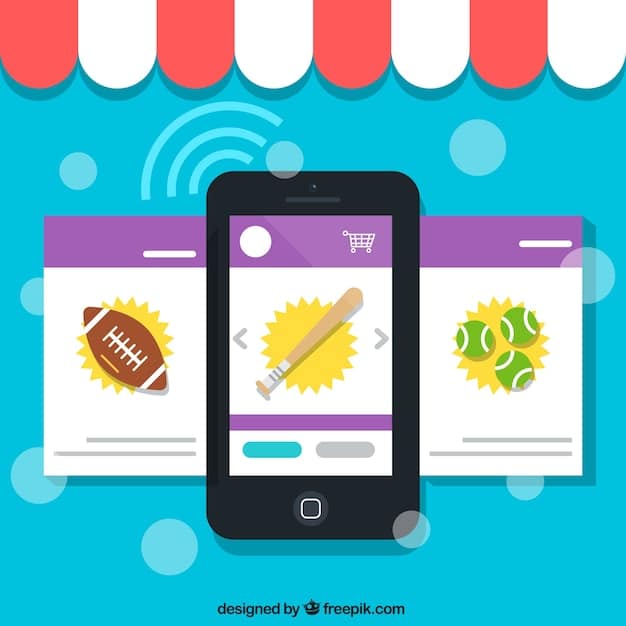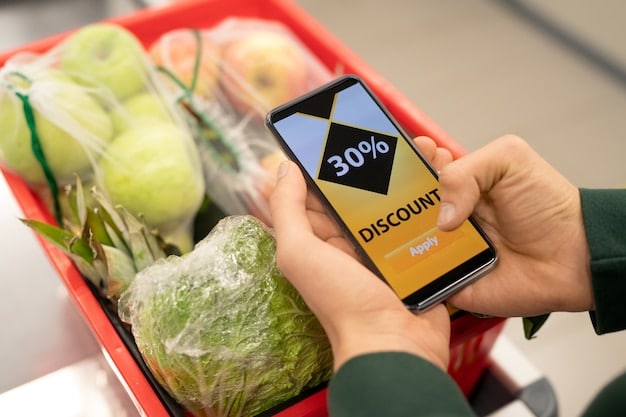Save Money on Groceries: Price Comparison Tools for US Shoppers

Price comparison tools for groceries enable US shoppers to save an estimated 10% weekly on their food bills by identifying the best deals and discounts available at local and online stores.
Are you tired of overspending on groceries? Discover how price comparison tools for groceries can help you save up to 10% on your weekly food bill in the US.
Top Benefits of Using Grocery Price Comparison Apps
Grocery price comparison apps are becoming increasingly popular in the US, and for good reason. They offer a range of benefits that can significantly impact your budget and shopping habits. These apps empower consumers to make informed decisions and maximize their savings.
Finding the Best Deals
One of the primary advantages of using grocery price comparison apps is the ability to quickly identify the best deals. Instead of visiting multiple stores or browsing numerous websites, you can use a single app to compare prices across various retailers in your area. This feature saves time and ensures you’re getting the most value for your money.
Saving Time and Effort
Traditional methods of comparing grocery prices can be time-consuming and exhausting. Driving to different stores to check prices or manually browsing online ads takes considerable effort. Grocery price comparison apps streamline this process, allowing you to compare prices from the comfort of your home or while you’re on the go. This efficiency can free up valuable time for other activities.
- Convenience: Access real-time price comparisons from your smartphone or tablet.
- Efficiency: Quickly find the best deals without visiting multiple stores.
- Savings: Reduce your grocery bill by consistently choosing the lowest prices.
In conclusion, grocery price comparison apps offer a convenient and efficient way to save money on your weekly shopping. By finding the best deals and reducing the time and effort required for price comparisons, these apps can significantly improve your budgeting and shopping experience.

Popular Grocery Price Comparison Tools in the US
The US market offers a diverse range of grocery price comparison tools, each with its unique features and benefits. Understanding the differences between these tools can help you choose the one that best fits your shopping needs and preferences. These tools range from comprehensive apps to specialized websites, all aiming to help you save money.
Flipp
Flipp is a popular app that aggregates weekly ads from local stores. It allows you to browse digital flyers and clip coupons directly from your phone. Flipp covers a wide range of retailers, including grocery stores, pharmacies, and home improvement stores. Its user-friendly interface and extensive coverage make it a favorite among US shoppers.
Basket
Basket focuses on creating shopping lists and comparing prices across multiple retailers. You can build a list of items you need and see the total cost at different stores. Basket also offers price tracking, notifying you when the price of an item drops. This feature is particularly useful for planning your shopping trips and taking advantage of sales.
- Comprehensive Coverage: Tools like Flipp offer extensive coverage of local retailers.
- Price Tracking: Basket helps you monitor price changes and find the best deals over time.
- User-Friendly Interfaces: Most apps are designed to be intuitive and easy to navigate.
These grocery price comparison tools provide valuable resources for savvy shoppers in the US. By understanding the features and benefits of each tool, you can make informed decisions and maximize your savings on groceries.
How to Use Price Comparison Tools Effectively
Using price comparison tools effectively involves more than just downloading an app. It requires a strategic approach to ensure you’re getting the most accurate and relevant information. By following a few simple tips, you can maximize your savings and make your shopping experience more efficient. Understanding how to navigate these tools is key to achieving optimal results.
Creating a Shopping List
Before you start comparing prices, create a detailed shopping list. This will help you stay focused and avoid impulse purchases. Include specific brands and sizes to ensure accurate price comparisons. A well-prepared shopping list is the foundation of effective price comparison.
Filtering and Sorting Results
Most grocery price comparison tools offer filters and sorting options. Use these features to narrow down your search results based on your preferences. For example, you can filter by store location, brand, or product category. Sorting by price can quickly reveal the best deals available.

- Accuracy: Ensure your shopping list is detailed to get accurate price comparisons.
- Customization: Use filters and sorting options to refine your search results.
- Regular Updates: Check prices regularly, as they can change frequently.
By following these tips, you can use price comparison tools more effectively and save even more money on your groceries. A strategic approach, combined with the right tools, can make a significant difference in your weekly food budget.
Potential Drawbacks and Limitations
While grocery price comparison tools offer numerous benefits, it’s important to be aware of their potential drawbacks and limitations. Understanding these issues can help you make more informed decisions and avoid common pitfalls. Recognizing these limitations is key to using these tools effectively.
Accuracy of Information
The accuracy of information provided by price comparison tools can vary. Prices may not always be up-to-date, especially for items that are on sale or subject to frequent price changes. It’s essential to double-check prices before making a purchase to avoid discrepancies.
Limited Store Coverage
Not all stores are included in every price comparison tool. Some apps may focus on larger chains, while others may have more comprehensive coverage of local retailers. Depending on your location and shopping preferences, you may need to use multiple tools to get a complete picture of available prices.
Despite these potential drawbacks and limitations, grocery price comparison tools remain a valuable resource for saving money on groceries. By being aware of these issues and taking steps to mitigate them, you can maximize the benefits of using these tools.
Real-Life Success Stories
To illustrate the effectiveness of price comparison tools, let’s explore some real-life success stories. These examples demonstrate how individuals and families have used these tools to significantly reduce their grocery bills. Hearing these stories can provide motivation and inspire you to try these tools for yourself.
Saving Hundreds of Dollars Annually
One family in California used grocery price comparison apps to save over $500 annually on their grocery bill. By comparing prices and planning their shopping trips around the best deals, they were able to significantly reduce their expenses. This story highlights the long-term financial benefits of using these tools consistently.
Finding Unexpected Deals
Another shopper in New York discovered unexpected deals on organic produce by using a price comparison app. They found that a local store was offering organic items at a lower price than conventional options at other retailers. This example shows how these tools can help you discover hidden savings opportunities.
- Significant Savings: Real users have saved hundreds of dollars annually.
- Unexpected Deals: Price comparison tools can reveal hidden savings opportunities.
- Improved Budgeting: These tools can help you plan and stick to your budget.
These real-life success stories demonstrate the tangible benefits of using grocery price comparison tools. By following their example and incorporating these tools into your shopping habits, you can achieve similar results and save money on your groceries.
Future Trends in Grocery Price Comparison
The landscape of grocery price comparison is constantly evolving, with new technologies and trends emerging regularly. Staying informed about these developments can help you take advantage of the latest innovations and maximize your savings. Understanding these trends is key to staying ahead in the world of frugal shopping.
AI-Powered Price Predictions
One emerging trend is the use of artificial intelligence (AI) to predict future price changes. Some apps are starting to incorporate AI algorithms that analyze historical data and market trends to forecast price fluctuations. This feature can help you plan your shopping trips more strategically and buy items when they are at their lowest price.
Integration with Smart Home Devices
Another trend is the integration of grocery price comparison tools with smart home devices. Imagine being able to ask your smart speaker to compare prices on milk or eggs and receive instant results. This seamless integration can make price comparison even more convenient and effortless.
- AI-Powered Predictions: Anticipate future price changes with advanced algorithms.
- Smart Home Integration: Seamlessly compare prices using smart home devices.
- Personalized Recommendations: Receive tailored deals based on your shopping habits.
These future trends promise to make grocery price comparison even more powerful and convenient. By staying informed and embracing these innovations, you can continue to save money and make the most of your shopping experience.
| Key Point | Brief Description |
|---|---|
| 💰 Save Money | Identify the best deals on groceries. |
| ⏱️ Save Time | Compare prices without visiting multiple stores. |
| 🛒 Smart Shopping | Create shopping lists and track prices. |
| 📈 Future Trends | AI-powered predictions and smart home integration. |
Frequently Asked Questions (FAQ)
▼
Savings vary, but many users report saving up to 10% weekly on their grocery bills by consistently choosing the lowest prices and taking advantage of deals.
▼
Most grocery price comparison tools are free, but some may offer premium features for a subscription fee. The basic functions are typically available at no cost.
▼
Price accuracy can vary. It’s always a good idea to double-check prices with the store’s website or app before making a purchase, especially for sale items.
▼
Yes, many grocery price comparison tools include online retailers like Amazon, Walmart, and Kroger, allowing you to compare prices for both in-store and online purchases.
▼
Yes, several grocery price comparison apps allow you to create and manage shopping lists. This feature helps you stay organized and ensures you don’t forget any items.
Conclusion
In conclusion, price comparison tools for groceries are invaluable resources for US shoppers looking to save money and time. By leveraging these tools effectively, you can significantly reduce your grocery bill and make informed purchasing decisions. Embrace these innovations and start saving today!





